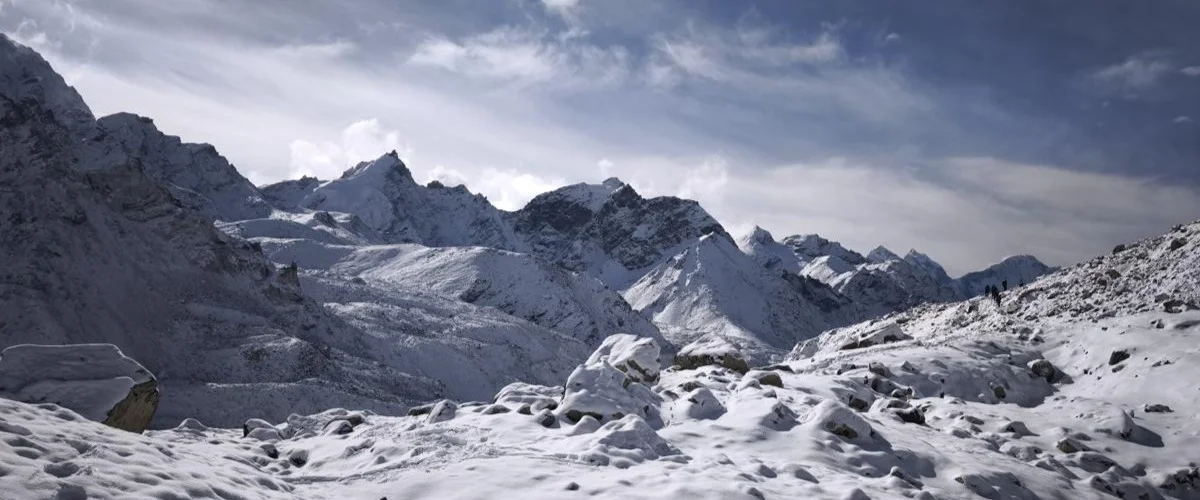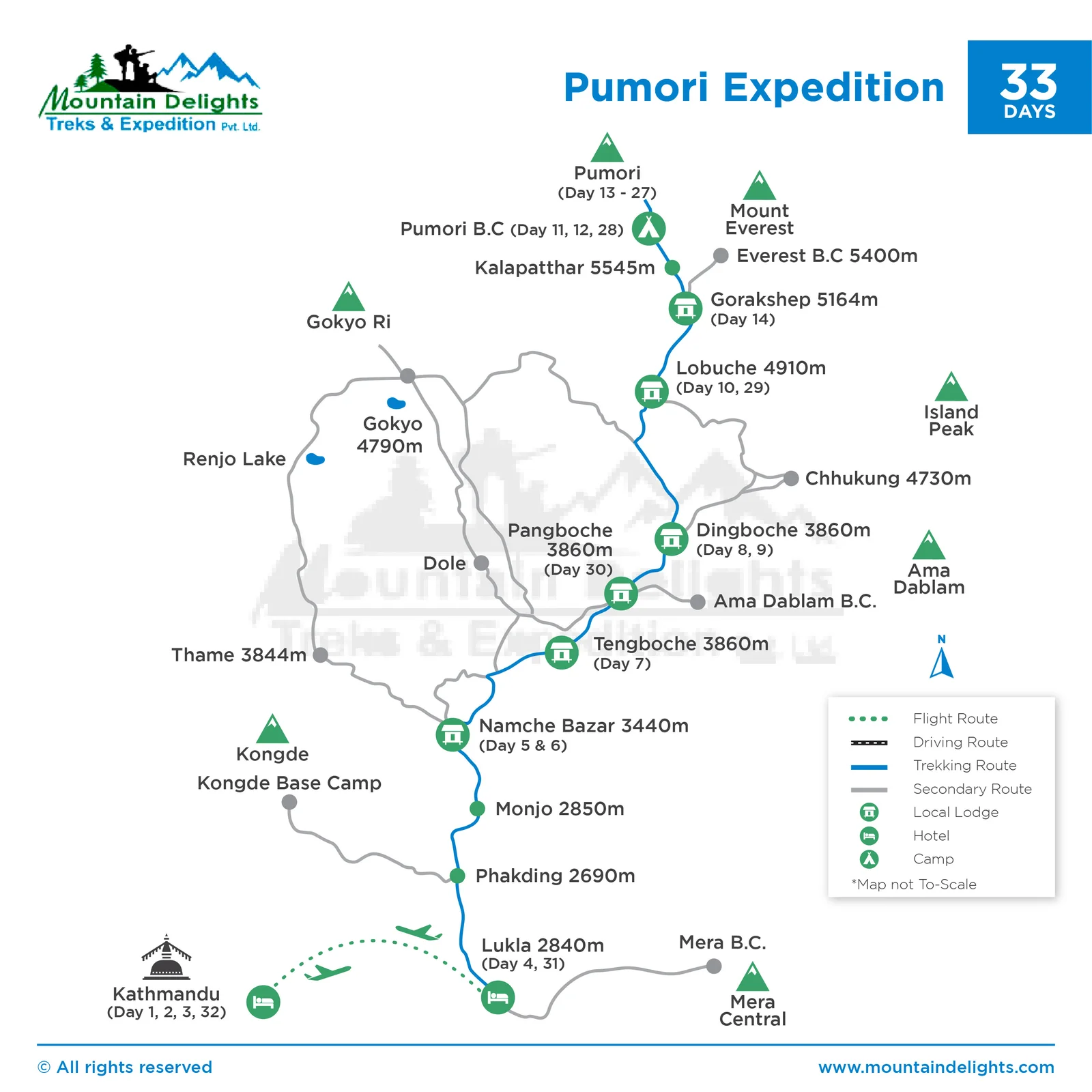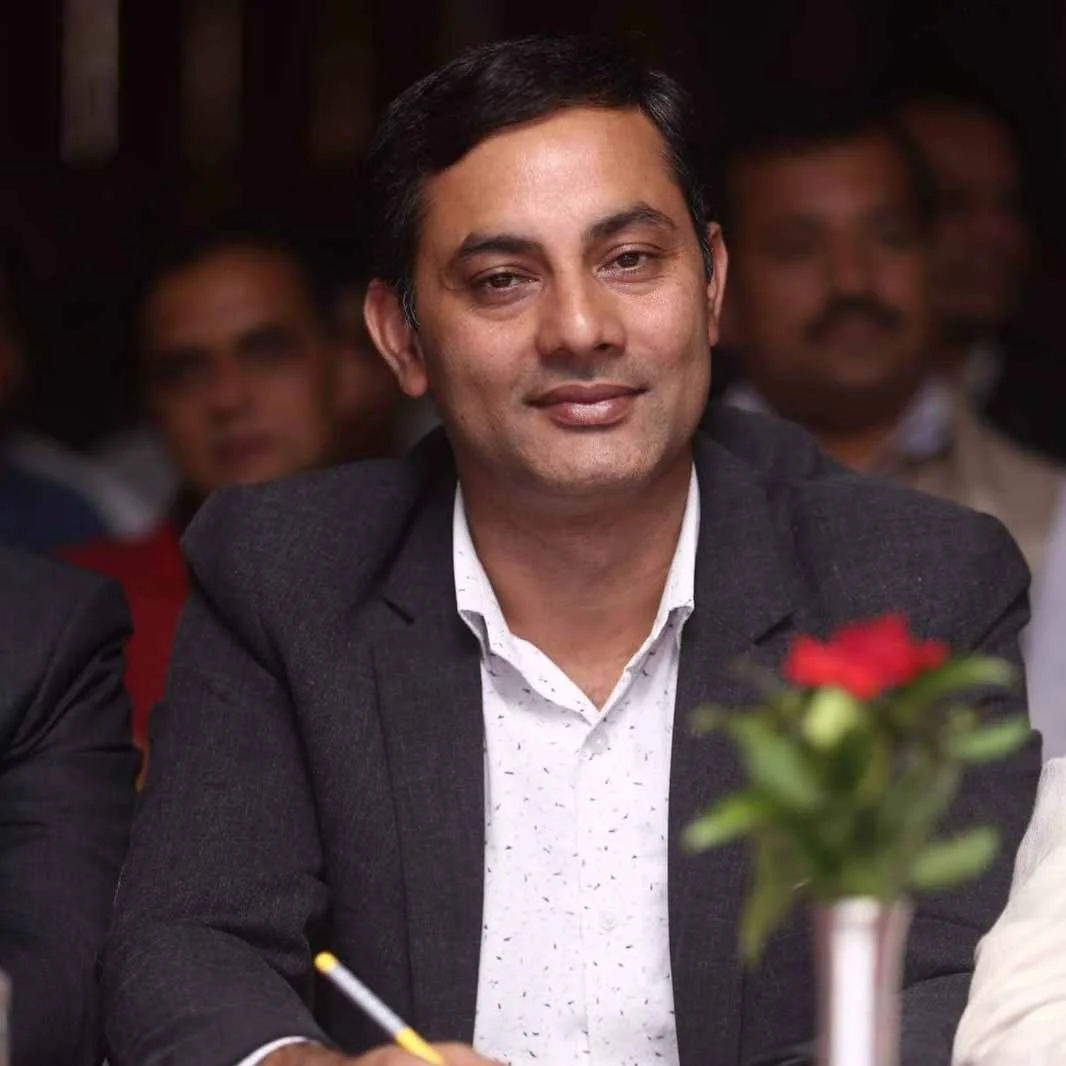
The Pumori Expedition Mt. Pumori, a pyramid-shaped 23,495-foot peak in the Khumbu region, dominates the skyline behind Kala Patthar (19,000 ft). The peak was named "Pumori" by George Leigh Mallory, which apparently means "unmarried daughter" in Sherpa.
The mountain was first climbed by a German-Swiss expedition led by Gerhard Lenser on May 17th, 1962, via the southeast face. Mr. Leopold Sulovsky of the Czech Republic and Zdenek Michalec of the Czech Republic ascended the South Face by a new route in 1996. The Pumori outlier Kala Patthar (5643 m/18,513 ft) emerges as a big brown hump beneath the spectacular south face of Pumori. The best months to visit this stunning peak are September to November and March to May.
We'll climb the southeast buttress in its lower reaches before traversing open snow slopes to a col with the East Ridge. When it comes to the route's condition, we must say that it is mixed and varied, and the ascent is not technically difficult. In the Pumori expedition, at least three camps will be established above the base camp. The Pumori Expedition's base camp will be located at an elevation of 5300 meters. Camp 1 will be built at 5700 meters, and Camp 2 will be built at 6200 meters. Similarly, Camp 3 will be established at an elevation of 6480 m.
We make our way to the Pumori cliff and eventually to the summit through crevasses. Passing through Namche Bazaar (the gateway to Mt. Everest), viewing the 200-year-old Tengboche monastery, Pangboche monastery, and panoramic vistas of dozens of spectacular Himalayan peaks are among the highlights of the Pumori adventure.
We climb through crevasses to the Pumori cliff and then to the summit. The Pumori expedition's specialties include passing through Namche Bazaar (the gateway to Mt. Everest), exploring the 200-year-old Tengboche monastery, Pangboche monastery, and panoramic views of dozens of great Himalayan peaks.
 Hotel
Hotel
 Lunch/Dinner
Lunch/Dinner
When you arrive at Kathmandu International Airport, our representative will meet you and welcome you to Nepal before transporting you to the hotel. After completing the check-in process, you can rest and relax at the hotel. After a short rest, we will take you on a short Thamel tour, which is the main tourist hub in Kathmandu, to familiarize you with some good restaurants, ATMs, money changers, supermarkets, gear shops, and other necessary items for your trip. After a brief exploration, you will be taken to our office for a trip briefing. Overnight stay in a hotel. If your arrival is late today, this tour and trip briefing will be shifted to tomorrow.
 Hotel
Hotel
 Breakfast/Lunch/Dinner
Breakfast/Lunch/Dinner
Sightseeing and Pumori Expedition Preparation You will explore the fascinating city of Kathmandu while the leader attends a formal briefing at the Ministry of Tourism. You will visit the famous Bouddhanath Stupa as well as the popular Hindu pilgrimage site, Pashupatinath Temple. The leader will check everyone's equipment in the late afternoon, as Kathmandu is the last chance to purchase any missing items. You will also meet your fellow expedition members and guides. Staying at a hotel for the night.
 Lodge
Lodge
 Breakfast/Lunch/Dinner
Breakfast/Lunch/Dinner
A scenic flight to Lukla in the early morning. We will meet our camp staff and porters in Lukla and depart immediately for our first night's stop in Phakding. Phakding is on the main trade route through the area and is located on the banks of the Dudh Kosi, which drains the entire Khumbu region. There are a number of clean, well-built lodges where we can spend the night.
 Lodge
Lodge
 Breakfast/Lunch/Dinner
Breakfast/Lunch/Dinner
Continue up the Dudh Kosi's banks, crossing it twice via small suspension bridges before arriving in Monjo, the gateway to the Khumbu National Park. Cross the Dudh Kosi and Bhote Kosi rivers on a high suspension bridge, then climb steeply for about two hours to Namche Bazaar. This prosperous trading town and the capital of the Khumbu region has authentic Tibetan artifacts.
 Lodge
Lodge
 Breakfast/Lunch/Dinner
Breakfast/Lunch/Dinner
We spend a day in Namche Bazar resting and allowing our bodies to become acclimatized to the altitude of 3,450m (11,300ft).
 Lodge
Lodge
 Breakfast/Lunch/Dinner
Breakfast/Lunch/Dinner
The well-worn Everest trail contours around the valley side high above the Dudh Kosi. Follow the path, taking in the first really good views of the Khumbu's great peaks: Everest, Lhotse, Nuptse, and Ama Dablam. Cross the Dudh Kosi River and make a steep climb to Thyangboche, home of an impressive and newly rebuilt monastery, passing through several villages and numerous tea shops.
 Lodge
Lodge
 Breakfast/Lunch/Dinner
Breakfast/Lunch/Dinner
Shaded by rhododendron trees, the path leads gradually down to the river once again to another airy suspension bridge. An hour's walking from here brings us to Pangboche, an excellent viewpoint for Ama Dablam. Contouring up the valley side, re-cross the river and turn up the Imja valley to reach the picturesque farming village of Dingboche.
 Lodge
Lodge
 Breakfast/Lunch/Dinner
Breakfast/Lunch/Dinner
This is a critical stage of the expedition. Dingboche is an excellent place to acclimate. The team leader will organize daily outings to the surrounding hills in order to provide gradual acclimatization. Walk some of the nearby hills to gradually increase your altitude exposure. Follow the acclimatization regimen that you previously found most suitable in order to achieve maximum acclimatization before arriving at base camp. While in Dingboche, we can attend a seminar on high altitude acclimatization at a Himalayan Rescue Association hospital near Pheriche. The walk to Pheriche and back will also be beneficial for acclimatization.
 Lodge
Lodge
 Breakfast/Lunch/Dinner
Breakfast/Lunch/Dinner
Come back to Pheriche before continuing on the trail to base camp. Reach Dugla, a convenient lunch stop located below the snout of the Khumbu Glacier. After lunch, the trail begins to climb steeply alongside the glacier moraine. The track eventually leads to a small cluster of tea houses at Lobuche after a couple of hours. While in Dingboche, we can attend a seminar on high altitude acclimatization at a Himalayan Rescue Association hospital near Pheriche. The walk to Pheriche and back will also be beneficial for acclimatization.
 Camp
Camp
 Breakfast/Lunch/Dinner
Breakfast/Lunch/Dinner
Contouring along the valley-side and looking down on the Khumbu Glacier, follow a reasonable trail to Gorak Shep. This was the site of the base camp in 1953 and now consists of a few small tea houses. Leaving Gorak Shep, the trail leads on to the moraine of the Khumbu Glacier and becomes quite vague, weaving between mounds of rubble and eventually reaching base camp near the foot of the Khumbu Icefall. This will be our home for the next six weeks.
 Camp
Camp
 Breakfast/Lunch/Dinner
Breakfast/Lunch/Dinner
Rest, Acclimatization and preparation.
 Camp
Camp
 Breakfast/Lunch/Dinner
Breakfast/Lunch/Dinner
Ascent of Mt Pumori.
 base camp
base camp
 Breakfast/Lunch/Dinner
Breakfast/Lunch/Dinner
All team members return to base camp and involved with packing expedition stores and cleaning the base camp area.
 Lodge
Lodge
 Breakfast/Lunch/Dinner
Breakfast/Lunch/Dinner
Retrace to Lobuche.
 Lodge
Lodge
 Breakfast/Lunch/Dinner
Breakfast/Lunch/Dinner
Trek to Pangboche.
 Lodge
Lodge
 Breakfast/Lunch/Dinner
Breakfast/Lunch/Dinner
Trek to Lukla.
 Hotel
Hotel
 Breakfast/Lunch/Dinner
Breakfast/Lunch/Dinner
In the morning we will take a flight to get back in Kathmandu from Lukla. After reaching Kathmandu and resting for some time. We will walk around Kathmandu's local town to experience the historical, cultural, and spiritual affluence, as well as to uncover social and historical mysteries and to view the artistic splendor. Kathmandu Sightseeing Tour in Kathmandu to photograph centuries-old monuments and historical crafts. We go to the Ason Local Market, the Indrachowk Glass Bead Market, the oldest supermarket on New Road in Kilagal, and the Hidden Stupa, among other places. Then we proceed to Kathmandu Durbar Square. The most unique experience in the square is a visit to the temple of the living goddess "Kumari." Durbar Square walking tour will be an ideal blend of culture, history, art, and architecture.
 Breakfast
Breakfast
Today, we will drop you off at the international airport to catch your flight back home, and we wish you a safe journey.



Discover more adventures like this one, offering the same incredible experiences and destinations. Find your next journey today!



































































The Pumori Expedition Mt. Pumori, a pyramid-shaped 23,495-foot peak in the Khumbu region, dominates the skyline behind Kala Patthar (19,000 ft). The peak was named "Pumori" by George Leigh Mallory, which apparently means "unmarried daughter" in Sherpa.
The mountain was first climbed by a German-Swiss expedition led by Gerhard Lenser on May 17th, 1962, via the southeast face. Mr. Leopold Sulovsky of the Czech Republic and Zdenek Michalec of the Czech Republic ascended the South Face by a new route in 1996. The Pumori outlier Kala Patthar (5643 m/18,513 ft) emerges as a big brown hump beneath the spectacular south face of Pumori. The best months to visit this stunning peak are September to November and March to May.
We'll climb the southeast buttress in its lower reaches before traversing open snow slopes to a col with the East Ridge. When it comes to the route's condition, we must say that it is mixed and varied, and the ascent is not technically difficult. In the Pumori expedition, at least three camps will be established above the base camp. The Pumori Expedition's base camp will be located at an elevation of 5300 meters. Camp 1 will be built at 5700 meters, and Camp 2 will be built at 6200 meters. Similarly, Camp 3 will be established at an elevation of 6480 m.
We make our way to the Pumori cliff and eventually to the summit through crevasses. Passing through Namche Bazaar (the gateway to Mt. Everest), viewing the 200-year-old Tengboche monastery, Pangboche monastery, and panoramic vistas of dozens of spectacular Himalayan peaks are among the highlights of the Pumori adventure.
We climb through crevasses to the Pumori cliff and then to the summit. The Pumori expedition's specialties include passing through Namche Bazaar (the gateway to Mt. Everest), exploring the 200-year-old Tengboche monastery, Pangboche monastery, and panoramic views of dozens of great Himalayan peaks.
When you arrive at Kathmandu International Airport, our representative will meet you and welcome you to Nepal before transporting you to the hotel. After completing the check-in process, you can rest and relax at the hotel. After a short rest, we will take you on a short Thamel tour, which is the main tourist hub in Kathmandu, to familiarize you with some good restaurants, ATMs, money changers, supermarkets, gear shops, and other necessary items for your trip. After a brief exploration, you will be taken to our office for a trip briefing. Overnight stay in a hotel. If your arrival is late today, this tour and trip briefing will be shifted to tomorrow.
Sightseeing and Pumori Expedition Preparation You will explore the fascinating city of Kathmandu while the leader attends a formal briefing at the Ministry of Tourism. You will visit the famous Bouddhanath Stupa as well as the popular Hindu pilgrimage site, Pashupatinath Temple. The leader will check everyone's equipment in the late afternoon, as Kathmandu is the last chance to purchase any missing items. You will also meet your fellow expedition members and guides. Staying at a hotel for the night.
A scenic flight to Lukla in the early morning. We will meet our camp staff and porters in Lukla and depart immediately for our first night's stop in Phakding. Phakding is on the main trade route through the area and is located on the banks of the Dudh Kosi, which drains the entire Khumbu region. There are a number of clean, well-built lodges where we can spend the night.
Continue up the Dudh Kosi's banks, crossing it twice via small suspension bridges before arriving in Monjo, the gateway to the Khumbu National Park. Cross the Dudh Kosi and Bhote Kosi rivers on a high suspension bridge, then climb steeply for about two hours to Namche Bazaar. This prosperous trading town and the capital of the Khumbu region has authentic Tibetan artifacts.
We spend a day in Namche Bazar resting and allowing our bodies to become acclimatized to the altitude of 3,450m (11,300ft).
The well-worn Everest trail contours around the valley side high above the Dudh Kosi. Follow the path, taking in the first really good views of the Khumbu's great peaks: Everest, Lhotse, Nuptse, and Ama Dablam. Cross the Dudh Kosi River and make a steep climb to Thyangboche, home of an impressive and newly rebuilt monastery, passing through several villages and numerous tea shops.
Shaded by rhododendron trees, the path leads gradually down to the river once again to another airy suspension bridge. An hour's walking from here brings us to Pangboche, an excellent viewpoint for Ama Dablam. Contouring up the valley side, re-cross the river and turn up the Imja valley to reach the picturesque farming village of Dingboche.
This is a critical stage of the expedition. Dingboche is an excellent place to acclimate. The team leader will organize daily outings to the surrounding hills in order to provide gradual acclimatization. Walk some of the nearby hills to gradually increase your altitude exposure. Follow the acclimatization regimen that you previously found most suitable in order to achieve maximum acclimatization before arriving at base camp. While in Dingboche, we can attend a seminar on high altitude acclimatization at a Himalayan Rescue Association hospital near Pheriche. The walk to Pheriche and back will also be beneficial for acclimatization.
Come back to Pheriche before continuing on the trail to base camp. Reach Dugla, a convenient lunch stop located below the snout of the Khumbu Glacier. After lunch, the trail begins to climb steeply alongside the glacier moraine. The track eventually leads to a small cluster of tea houses at Lobuche after a couple of hours. While in Dingboche, we can attend a seminar on high altitude acclimatization at a Himalayan Rescue Association hospital near Pheriche. The walk to Pheriche and back will also be beneficial for acclimatization.
Contouring along the valley-side and looking down on the Khumbu Glacier, follow a reasonable trail to Gorak Shep. This was the site of the base camp in 1953 and now consists of a few small tea houses. Leaving Gorak Shep, the trail leads on to the moraine of the Khumbu Glacier and becomes quite vague, weaving between mounds of rubble and eventually reaching base camp near the foot of the Khumbu Icefall. This will be our home for the next six weeks.
Rest, Acclimatization and preparation.
Ascent of Mt Pumori.
All team members return to base camp and involved with packing expedition stores and cleaning the base camp area.
Retrace to Lobuche.
Trek to Pangboche.
Trek to Lukla.
In the morning we will take a flight to get back in Kathmandu from Lukla. After reaching Kathmandu and resting for some time. We will walk around Kathmandu's local town to experience the historical, cultural, and spiritual affluence, as well as to uncover social and historical mysteries and to view the artistic splendor. Kathmandu Sightseeing Tour in Kathmandu to photograph centuries-old monuments and historical crafts. We go to the Ason Local Market, the Indrachowk Glass Bead Market, the oldest supermarket on New Road in Kilagal, and the Hidden Stupa, among other places. Then we proceed to Kathmandu Durbar Square. The most unique experience in the square is a visit to the temple of the living goddess "Kumari." Durbar Square walking tour will be an ideal blend of culture, history, art, and architecture.
Today, we will drop you off at the international airport to catch your flight back home, and we wish you a safe journey.

© 2011 - 2022 All rights reserved. Mountain Delights Treks and Expedition Pvt. Ltd. Developed By : Xenatech Nepal